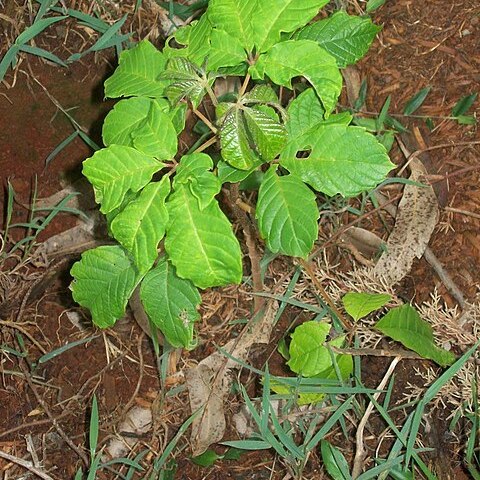Tree 12–30 m. tall, up to 1.8(–2.3) m. in diameter; bole 12–18 m. tall; bark very thin, rough and slightly fissured; slash creamy yellow turning dirty green; stems, petioles and leaf-venation beneath with longer more shaggy indumentum than in V. fischeri.. Leaves 5-foliolate; leaflets obovate, 5.5–17 cm. long, 3.2–8.5 cm. wide, broadly rounded to obtusely acuminate at the apex, cuneate to rounded at the base, coriaceous, usually drying darker than in V. fischeri, sparsely puberulous above, paler beneath and completely covered with soft ochraceous tomentum and glands but becoming sparser; petiole 13.5–17 cm. long; petiolules ± absent or intermediate one 0.6–4 cm. long.. Cymes ochraceous tomentose, somewhat more lax than in V. fischeri forming axillary panicles up to 12 cm. long, 24 cm. wide; peduncles 6.3–13 cm. long; secondary branches to 4.5 cm. long; pedicels 1–4 mm. long, densely tomentose; bracts 0.5–1 cm. long, 1–4 mm. wide.. Calyx densely ochraceous tomentose, rather more distincdy toothed than in V. fischeri; tube 2 mm. long, lengthening to 5–6 mm. in fruit; teeth broadly triangular, 0.5 mm. long, lengthening to 3 mm.. Corolla white or white tinged blue with largest lobe mauve; tube curved, 5–6 mm. long, ochraceous tomentose above outside; limb 8–10 mm. wide, the largest lobe round or ovate, 3–5 mm. long, 3.5 mm. wide, entire, the others 2.5–3 mm. long, 2 mm. wide, slightly emarginate, densely ochraceous tomentose outside.. Ovary globose, with simple hairs and sparse glands; style filiform, 6 mm. long; stigma-lobes linear.. Drupes black with white spots, obovoid, (1.1–)2.2–2.4 cm. long, (0.8–)1.3–1.5 cm. wide, shiny, glabrous, rounded at the apex, ± contracted to the base; mesocarp fleshy; endocarp very woody, the putamen ± 2 cm. long, 1.1–1.2 cm. wide, 6–7 mm. diameter at the base, obtusely 4-angled; calycine cup 1.1 cm. wide.
More
A tree which loses its leaves. It grows 20 m high. It can be 30 m high along river banks. The trunk is clear and straight. The bark is pale brown. It has narrow grooves along it. The leaves are compound. They have 5 leaflets which are light green. The leaf stalk is long and hairy. The leaves droop when young. They have a pointed tip. The leaflets are pale underneath with velvety hairs. The flowers are small and cream with one mauve petal lobe. The flowers are 1 cm long and occur in large heads. The fruit are rounded and 1.5 cm across. They are green but become black when ripe. The fruit are edible.
Can be grown by seedlings. Seeds needs soaking.

